#the dvd i just put in (inspiring this post) has a promo for blu rays at the beginning
Text
i love dvd's..... movie trailers and previews! menu screen!! bonus content!!! slightly gritty video quality!!!! it feels more real
#the dvd i just put in (inspiring this post) has a promo for blu rays at the beginning#'discover the blu ray experience!'#'1080 hd!'#'surround sound!'
1 note
·
View note
Text
Bloom Into You, a Blu-ray review
(Disclaimer: The following is a non-profit unprofessional blog post written by an unprofessional blog poster. All purported facts and statement are little more than the subjective, biased opinion of said blog poster. In other words, don’t take anything I say too seriously.)
Just the facts 'Cause you're in a Hurry!
Manufacturer’s Suggested Retail Price (MSRP): 69.98 USD
How much I paid: 45.99 USD , the pre-order price
Animation Studio: TROYCA
Licensed and Localized by: Sentai Filmworks
Audio: Japanese Audio with Subtitles and English Dub available.
English Cast: Tia Ballard as Yuu Koito, Luci Christian as Touko Nanami, Shanae’a Moore as Sayaka Saeki, Amber Lee Connors as Akari Hyuga, Brittney Karbowski as Koyomi Kano, Patricia Duran as Riko Hakozaki and Samantha Stevens as Miyako Kodama.
Number of Episodes: 13 Episodes
Length per Episode: 25 Minutes on average. 21 Without Intro and Ending song.
Number of Discs: 2 Blu-ray discs
Episodes per Disc: Episodes 1 through 9 on the 1st Blu-ray Disc. Episodes 10 through 13 on the 2nd Blu-ray disc.
Does this come a digital voucher to redeem?: No. This only has the Blu-ray discs.
Are there plans for a DVD release: Not as of the writing of this review.
Also on: HiDive, Sentai Streamwork’s Streaming Service.
Bonus Features: Clean Opening Animation, Clean Closing Animation and two Japanese Promos.
Notable Localization Changes: For the most part, Bloom Into You sticks as close to the original Japanese script as possible.
Which Edition are you reviewing: The Standard Edition, that comes with just the Blu-rays.
What does the other Edition come with: The Premium Box Set comes with a Special Book, Storyboard Book, Original Scriptbooklet, 6 art cards and Rei’s receipe for cheesecake. (Yes, really). It is priced at 149.98 USD.
My Personal Biases: I’ve seen Kannazuki no Miko, Strawberry Panic, Maria Watches Over Us, Kase-san and Morning Glories, Kashimashi: Girl Meets Girl, Simoun, Citrus, Valkyrie Drive: Mermaid, Revolutionary Girl Utena, Yurikuma Arashi, Sweet Blue Flowers, Whispered Words and others. To say I’ve been waiting for something like Bloom Into You would be an understatement.
My Verdict: Not only does Bloom Into You stand amongst the pinnacles of Yuri anime, it outshines some regular romance shows in the process. Yuu and Touko feel like fully fleshed out characters instead of the usual stock types and gives ample amount of time to not only developing the main girls but the rest of the cast as well. My hopes is that the success of this show will spawn a 2nd season. Buy it!
A/N: SPOILERS for this show and other Shoujo-ai shows below.
Bloom Into You a Bluray review
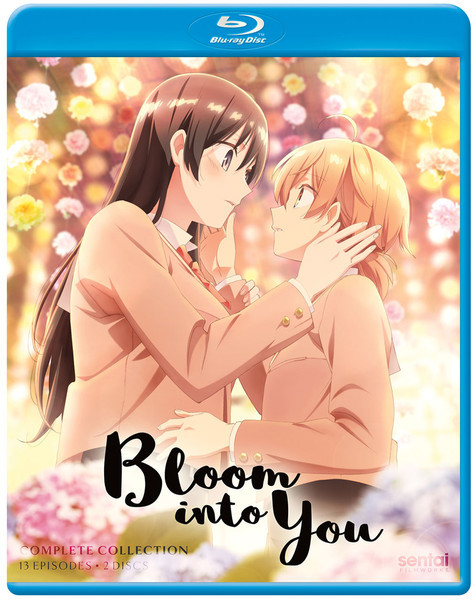
youtube
I honestly think many newcomers to the Shoujo Ai genre don’t know how good they have it nowadays.
I’ve said it before, but it bears repeating. Before the 1-2-3 Punch of Strawberry Panic, Kashimashi: Girl Meets Girl and Simoun in 2006, Kannazuki no Miko was considered the pinnacle of Yuri Anime.
But in 2018, Yuri anime seemed to make a comeback in full force with the 1-2-3 punches of Kase-san and Morning Glories, Bloom Into You and, yes, Citrus. The three adaptations of manga titles managed to be an oasis in the desert after titles such as Simoun failed to find an audience, Sweet Blue Flowers ending on a cliffhanger and Whispered Words bombed so hard, it was rumored to have killed the Yuri anime genre for years. Even titles after that such as Yurikuma Arashi and Valkyrie Drive: Mermaid didn’t manage to find a larger audience other than the converted niches they were aiming for.
But then, Bloom Into You came onto the scene and became a revolution, for both longtime fans of the genre and newcomers. Bloom Into You didn’t just manage to be a critical success, but also managed to be a commercial juggernaut, spawning a stage play, multiple light novels and having numerous books of its manga sold.
Freshman high schooler Yuu Koito has always loved shojou manga, so she is aware of what she ought to be feeling if she were to receive a love confession. But when a junior high classmate confesses his feelings for her, she somehow does not feel anything. She delays her response, and ends up entering high school, still unsure of how to respond to those type of feelings. While there, she happens to see the student council president, Touko Nanami, elegantly turning down a confession. Yuu is inspired to ask her for advice. She finds out that Nanami has never accepted a confession because none of them has ever made her feel anything in particular. The two bond over their similarities. Nanami realizes that she could be falling in love with Yuu, so she suddenly confesses her feelings to her.
This isn’t the first time we’ve seen the upperclassman and lowerclassman (or the Senpai and Kouhai) relationship. We’ve seen countless pairings with Sachiko and Yumi or Shizuma and Nagisa or Amane and Hikari or Utena and Anthy or Asuka Rei and Nanako or… you get the idea. (I watch a lot of Shoujo ai). Even when it’s established both girls are of the same age such as Kannazuki no Miko’s Chikane Himemiya and Himeko Kurusugawa or Kase Tomoka and Yui Yamada, there’s a notable class difference between the popular girl and the unpopular girl.
But Touko and Yuu take all those past pairings and put them to shame. Yuu actually does feel like a fully fleshed out human being with her own agency and thoughts (a far cry from the naïve Himeko Kurusugawa and Nagisa Aoi). Yuu isn’t sure if she’ll ever be in a relationship and we’re treated to her inner monologue of whether she is capable of loving Touko the same way Touko loves her. At the same time, the more we see Touko, the more the outer exterior falls apart. Interior voice-over is said to be a lazy storytelling technique in fiction, but Yagakimi uses it to explore the very real and unsure feelings of Yuu.
Yes, the trope of ‘the popular girl isn’t perfect after all’ trope has been done to death with Chikane, Shizuma, Shizuru, Asuka and others, but Touko feels particularly tragic as she’s locked in arrested development. Touko’s been trying to live in the footsteps of her deceased sister who was also Student Council president, only to find out that her sister wasn’t the image she always had in her head. It’s up to Yuu to find a way to save Touko from herself.
Also, no one rapes or tries to rape each other. So, you know, progress!
Also a breath of fresh air are the additions of other queer characters such as an older lesbian couple living together and Sayaka Saeki, Touko’s classmate who also harbors romantic feelings for Touko. Sayaka has been a fan favorite in the franchise and even has a Light Novel adapted after her. (Though spoilers indicate she’s to join the ranks of ‘lesbian best friend who is friendzoned by love interest’ alongside Strawberry Panic’s Tamao Suzumi and Yaya Nanto, Hajimete no Gal’s Ranko Honjou and Cardcaptor Sakura’s Tomoyo Daidouji).
Sentai Filmworks did the localization of the show and for the most part, it has been a very solid translation to little or no changes.
Luci Christian (who’s voiced Honey-sempai in Ouran High School Host Club and other lesbian characters such as Himiko from Shattered Angels) really brings a lot of range to the character. But Tia Ballard (who performed Teruhashi from the Disastrous Life of Saiki K, Marron in Dragon Ball Super and Lady Rain from Valkyrie Drive: Mermaid) manages to wring out real depth through Yuu. Her performance is subtle, slow and has enough energy to make it feel real.
Rounding out the cast are familiar voice performers. Amber Lee Connors (who voiced Mei Aihara in Citrus) is nice to hear and Brittney Karbowski turns in a surprisingly toned down character, a far cry from some of her more energetic performances.
JAPANESE AUDIO WITH SUBTITLES IS ALSO AVAILABLE.
CAVEAT: Through Shoujo-ai’s vast, incredible and at times, problematic, history, we’ve seen milestones and steps being placed into BiY’s direction. Slowly but surely, the path was being placed as every woman love woman anime placed its mark to getting here. From the tragedies in the past, to the slice of life shows to the shows pandering to titillation, Bloom Into You is not only an accomplishment in its own right, but a climax to every other shoujo-ai show out there. My only hope is that we get the much deserved 2nd season and adapt the rest of the wonderful manga.
Verdict: Full Price!
youtube
#bloom into you#bloom into yuu#yuu koito#sayaka saeki#touko nanami#sentai filmworks#tia ballard#luci christian#lgbt#shoujo ai#yuri
15 notes
·
View notes
Text
[2:05 pm-ish, April 20, 2019]
Man, there is nothing that puts me in a fouler mood than when I let my own personal procrastination demon get the better of me on a perfectly free Saturday to the point that I don’t start getting any writing done until after 2 in the afternoon. I had planned to get up early and everything, and I even did. Sort of.
I scrolled through a ton of YouTube videos first, and before I knew it, it was nearing ten in the morning and I still needed to eat something. Ugh, so I did that…and then I committed the sin of hibernating on the couch for a couple of hours to catch up on some anime-related stuff. Though it was the sort that always manages to fuel my inspiration and imagination.
[Present Day]
Okay, I know what you’re thinking: that all’s no excuse, every procrastinating writer says that as they convince themselves to turn on Netflix or Hulu to “get inspiration” instead of writing and end up marathoning that show they really just want to finish so they’re caught up with everyone else, and because they love it so much.
Just the same, it did give me what I needed to open up my laptop and start working towards my writing goal for the day working on editing and polishing my manuscript: I finally got around to watching Kara No Kyoukai: Mirai Fukuin – Recalled Out Summer and Recalled Out Summer: Extra Chorus.
Okay, now that probably doesn’t mean a whole lot just by a name-drop, but let me explain. After all, that’s the whole point of this blog post: My love letter to Type-Moon. (And yes, I realize I’m not the first person to express said love in a blog post.)
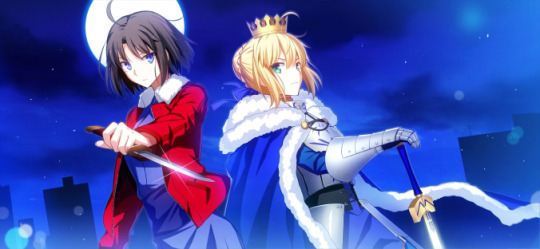
Saber from the Fate Series and Ryougi Shiki from Kara No Kyoukai: The Garden of Sinners
Type-Moon is a Japanese game company known primarily for their visual novels. Not really a thing here in the West, at least not as much if at all, but when I was first introduced to the concept of visual novels, I thought of them as choose-your-own-adventures played as an electronic game rather than read as a book. As I’ve come to better understand it, it’s kind of like that, you do make certain decisions that can lead to certain endings, but sometimes, as in the case of arguably Type-Moon’s most well-known visual novel, Fate/Stay Night, the point is to play through three different versions of the same story premise: kid gets dragged into ancient battle royale known as the Holy Grail War, and with each version of the story, or “route”, being played through, each featuring a different heroine for our protagonist, Shirou Emiya. One route builds upon the previous, and each route gets subsequently darker in terms of plot points and content.
Fate/Zero, incidentally (and my #1 favorite anime ever), is the prequel to that, and succeeds where most prequels don’t, since it’s a tragedy (I’ll go into more detail on that in my upcoming post about how Fate/Zero succeeds as a prequel). That was written as a light novel (kinda like a YA novel, or well, a shorter novel, so “light” novel) before it was adapted into an anime, and sets up the events of all three routes in Stay Night. So, it confirms that no matter what route you’re in in Stay Night, the events of Zero hold true for each of them. (Which is interesting when you consider the damage some of the characters in Stay Night have been living with since Zero, yet they may or may not come up in Stay Night depending on what route’s being played.)
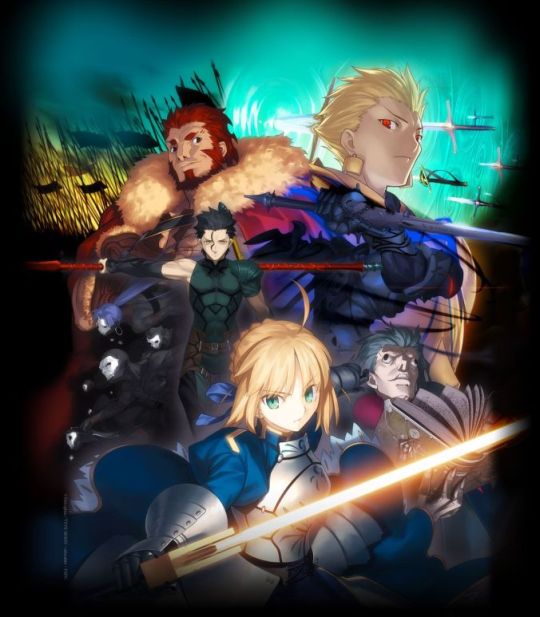
Cover art for Fate/Zero blu-ray box set
The co-founders of Type-Moon, writer Kinoko Nasu and illustrator Takashi Takeuchi, have come up with some pretty interesting and awesomely cool material in my opinion, and not only for Stay Night, which ultimately culminated in launching the Fate franchise, which has…a HUGE number of titles, and with the anime adaptations of Zero, the original of Stay Night, and the reboots of Stay Night covering the two subsequent routes that the original couldn’t really cover, a bunch more titles in the franchise have each been getting their own anime adaptations in turn, as though there was suddenly this HUGE frenzy for Fate title after Fate title to be adapted into an anime, demonstrating just how sprawling the lore and fanbase of this franchise is.
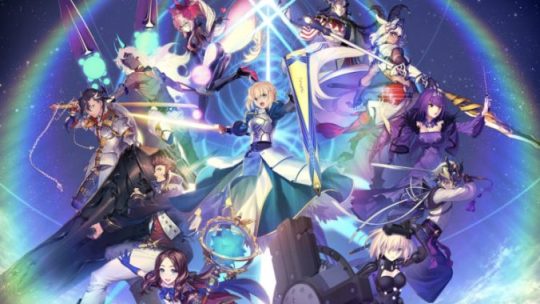
Promo art for Fate/Grand Order
And if that weren’t enough, there isn’t just Fate, there are other Type-Moon-developed visual novels whose worlds are connected to that of Fate. The only two I’m aware of for sure are Tsukihime and Kara No Kyoukai. (And then there’s Canaan, which was developed by Type-Moon too and its wonderful little 13-episode series in its own way, though I’ve been unable to verify for sure just how much if at all it’s connected with the aforementioned titles.) While I haven’t been able to get into Tsukihime much at all, since I can’t shell out to get my hands on the original visual novel, translated or not, and the anime is notorious for sucking so much that most deny it even exists, I have been able to get into Kara No Kyoukai, a series of films adapted originally from a seven-series online novel written by Nasu, and are seen by many as primers to the world of the Nasuverse (or the world of Type-Moon), which makes sense since when you see it you can recognize characters and plot points that feel like they were taken and reworked for things like Fate. Despite that though, they still do in fact exist in the same universe all as their own characters with their own stories.
Yeah it’s a lot. And the Kara No Kyoukai films cost a pretty penny, but this year I at long last got my hands on both the bluray box set of both the original seven films, as well as the additional film (Future Gospel and Recalled Out Summer: Prelude), and the extra special (Recalled Out Summer: Extra Chorus) just this year–stories that Nasu had an idea for after the original seven came out, but had not written in novel form. I’ve watched the first seven several times at least, but I was hesitant for the longest time about seeing the eighth film and the extra specials, since the first seven tied together so satisfyingly well, to put it mildly. But I finally gave in because I just love Type-Moon that much. And in the end, I was happy I got it, if only to have more Type-Moon in my life.
And that love compelled me to write out, essentially, a love letter conveying that love to Type-Moon. I’ve developed a lot of plot points for both my novel manuscript, as well as my style and voice as a writer, from the material I’ve seen from Type-Moon.
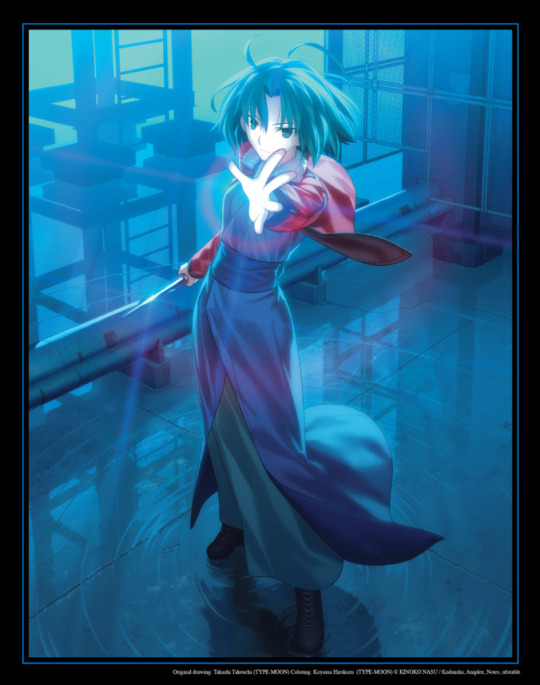
Cover art for blu ray box set of Kara No Kyoukai: The Garden of Sinners original seven-film series
Fate/Zero was my induction, the jumping off point from which I finally took the plunge (some would argue watching the 2006 adaptation of the first route of Fate/Stay Night first is more prudent, but if I’m being honest, I tried that, and just couldn’t get through it knowing something like Fate/Zero was out there–I just couldn’t wait, though eventually I did end up owning and watching the original 2006 Stay Night, mostly because I was starved for Fate material until more of the anticipated new content came out, and because I was able to get a DVD copy of the series for $10.00–more than worth it, it turned out).

Promo art for Fate/Stay Night (2006)
Anyway, Zero pulled me in not just with eye-candy, godly levels of animation quality unprecedented in an anime TV series (considering how much budgeting goes into animation on the whole in the industry), and not just with its very epic concept of the Holy Grail War and all that that entailed as well, but also with its characters.
I adored Waver Velvet, the underdog student of magecraft who, despite being in over his head as the youngest participant in the War, manages to summon the hero Alexander the Great to act as his Servant, the one who’ll fight the other Masters by proxy with Servants of their own, all of them famous figures plucked from history and legend (with some creative license, in some cases a lot). And throughout the course of the War, they form an admirable friendship.
I despaired over the fate of Kariya Matou, who was basically the character that every show like this has, the one that gets ALL THE CRAP thrown at him, and undeservedly of course, as he tried so hard to win just for the sake of saving a girl from the abuses of her adoptive family, even with the cards stacked against him.
I relished in the development of the villain Kirei Kotomine, who could’ve just come off as your typical priest-that’s-secretly-a-bad-seed, but instead is SO much more than that, and it’s awesome.
Then there’s Gilgamesh, the sort of OP, arrogant villain you love to hate, but also the kind that has the power to back up his boasting being master of the universe.
Then you’ve got Saber, i.e. King Arthur, who despite apparently really being a girl named Arturia, all this time, still lives up to the namesake of the legendary King of the Britons.
And of course, my favorite of all, Kiritsugu Emiya. The relationship he shares with his wife, Irisviel von Einzbern, and their daughter, Illya; the motivations for why he does what he does unfolding as the show progresses, culminating in him finding redemption in at least being able to save the life of his eventual-adopted son, Shirou from the War’s fiery collateral damage at its climax; the epic rivalry between him and Kirei Kotomine; the way his methods clash with Saber’s chivalric values; the fact that he gets all of the best qualities of what I love so much about Takashi Takeuchi’s character designs. (Which is another way of saying he’s drawn so appealingly to me that he’s made it to #1 on my list of husbandos. That’s right, I said it!) The whole story and arc of his character is one of the, if not the, most poignant things I have ever seen in an any form of media. Never has a character made me physically ache at the thought of everything he went through, combined with the bittersweetness of his and Irisviel’s love story, as well as that of his love for Illya.
It’s basically everything I’ve ever wanted in a story’s emotional core or emotional foundation, and definitely served as a turning point in terms of my own writing, particularly seeing as how it’s a feels dynamic I’ve wanted to write for years. So thank you for that, Type-Moon: somehow, some way, much in the way that the universe miraculously weaves together a human being by a near infinite number of factors, you’ve managed to craft my own personal Holy Grail of an emotional story component.
Indeed, since the discovery of the Kiritsugu x Irisviel ship (an underappreciated gem depending on who you talk to), I haven’t found any ships to exceed that level of emotional perfection. I’ve found ones that come close, even ones that equal it, but thus far, in my eyes, Kiri x Iri is unrivaled, and probably never will be.
Sadly, this scene was not in the anime. Just in the Realta Nua re-release of the Fate/Stay Night VN game for PSP. 😦
In terms of ones that have equalled it though, one of those came unsurprisingly from another Type-Moon work, the aforementioned Kara No Kyoukai, and its main romantic core of the delightfully darkly complicated relationship of Ryougi Shiki and Kokutou Mikiya. That was another pleasant surprise. I had already fallen hard for Fate/Zero and everything it had to offer, but I’d heard of Kara No Kyoukai before that. It had been on my to-watch list for a while, but I’d say that learning that it takes place in same universe as Fate, the Nasuverse that is, it sort of drove me to get my hands on it a little sooner.
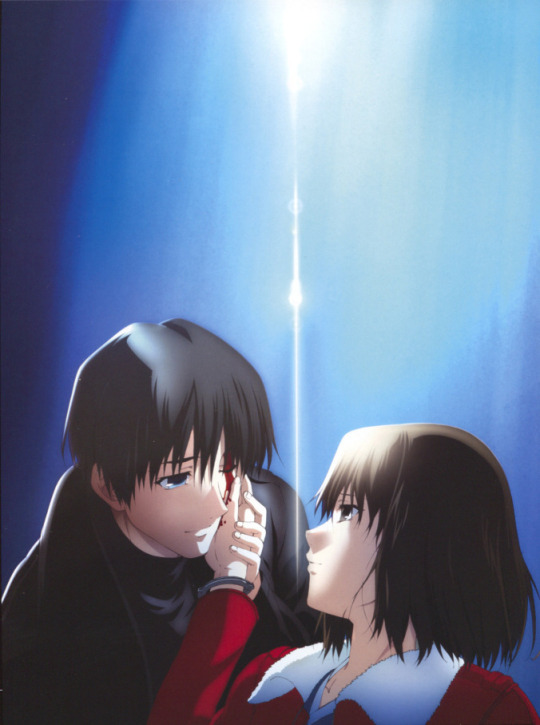
Cover art for Volume IV of the box set for Kara No Kyoukai: The Garden of Sinners VII: …not nothing heart, with Shiki and Mikiya (OMG the feels)
My first copy was, admittedly, one of those many, many bootlegs floating around eBay (hem, hem), but at long last (especially since I got a bluray player (FINALLY) for this past Christmas), I was able to purchase the beautiful bluray boxset release of all seven movies, plus the special edition bluray for the Recalled Out Summer extras, because why not? Sure, again, the latter works basically as a sort of sweet but small desert to a large delicious main course, but that sweetness is worth it regardless, because it’s sweet, especially when you get treated to sweet strawberries in that sweet strawberry Hagan-Dasz ice cream of an extra story of things like seeing that (SPOILERS) Shiki and Mikiya eventually have an adorable little daughter named Mana, who for her limited screen time, does indeed seem to be the perfect blend of her parents. Plus it’s just great to see something so normal yet wondrous result from a romance that if not for a saving grace or two, probably would’ve ended in bloody tragedy.
Cover art for Recalled Out Summer box set featuring Shiki and Mikiya
Cover art for Recalled Out Summer blu ray set featuring Ryougi Mana (Shiki and Kokutou’s daughter, and Mitsuru Kamekura
So yeah, I’ve come to learn that when it comes to Type-Moon, where romance and personal relationships come in, the writing nine times out of ten shines (with the first true failure to connect with me coming in Fate/Extra Encore, and even then, because of the production studio behind it, it at least benefited me with flashbacks triggered by similar imagery used in another one of my favorite anime, Madoka Magica).
Again, sorry I haven’t been able to get into Tsukihime, but I’m not completely blind. There’s that anime adaptation that doesn’t exist ha, ha. In all seriousness though, I’m familiar with the basic premise, and some of the plot points seem to overlap other Type-Moon works. Plus there’s Wikipedia.
And Carnival Phantasm! Which is a little series Type-Moon produced as a celebration of their ten-year anniversary, something to reward the fans for being fans, and while I was at a disadvantage where a lot of the Tsukihime material came up, I still enjoyed it well enough, going on what I knew. But seeing as how Fate is arguably the most successful Type-Moon franchise, the ratio of Fate to Tsukihime material was almost 2:1. Which was awesome, as I basically got to see Type-Moon not only poke fun at itself and parodize its own characters, but actually give a sunnier if brief existence for some of these characters (because quite a lot of Type-Moon characters’ actual lives are SUCKY to put it lightly).
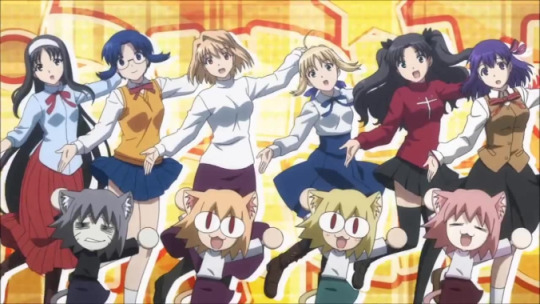
Screenshot of the Carnival Phantasm OP
For as sprawling as the lore of Type-Moon’s stories have grown, particulary with their Fate/Grand Order online game which seems to explore every single available Heroic Spirit that can be summoned as a Servant for your very own Holy Grail War, and the events of which have also been getting adaptations (the most recent exploring Gilgamesh’s past, and that has me intrigued if I’m being honest), there’re so many buried gems to find in there in terms of character and ideas and thoughts on life. Kara No Kyoukai in particular tends to philosophize quite a bit and contemplate things like reality, time, identity, balance, building a foundation for the world as a whole according to the Nasuverse. A bit like comic books, Fate in particular is one of those things where it’s debatable anymore where one should start, some answers being more correct than others, but once you find a place where you dip your toe in and get accustomed to the water, it’s easy to get wrapped up in what it’s various stories centered around the Holy Grail War are concerned.
I love stuff like that, and I’ve been inspired in my own work not just by Type-Moon on its own, but studio ufotable as well, which seems to be the ultimate Fate adaptation machine. Sure other studios do some of the lesser known titles (again like Extra), but ufotable got the reboot of Fate/Stay Night‘s second route, Unlimited Bladeworks, the adaptation of Fate/Zero before that, the film trilogy adaptation of the final Fate/Stay Night route Heaven’s Feel, and even the lighthearted quasi-AU Today’s Menu for Emiya Family, which is the Stay Night story if it was taken over by a cooking show, almost like Carnival Phantasm but not a parody, and still acknowledging the darker parts of the Fate universe, if distantly. Something about the care ufotable puts into their characterizations, along with the animation and art quality and the awesome voice-acting for the seiyuu and English VAs that end up getting casted (although I’m aware where the English casts are concerned that comes from the western licensing company that picks it up and not actually studio ufotable).
And then with Kara No Kyoukai, also made by ufotable, you get an expanse on this universe and its mechanics. It’s a bit vague on how magic works in both this and Fate, but I’ve actually found the idea of basing fantastic elements in the real word fascinating, not urban fantasy but something more than that. And the concepts it brings up. Like people having these things called “origins”, a certain trait from which their soul or being originated from within the Akashic Record, or “The Route” that once “awakened” in a person causes that trait to consume them. So if a person’s origin is “to consume”, and that’s awakened in that person (this requires a mage and the consent of the person who’s origin is being awakened), then they’ll say…embrace their desire to slaughter people en masse and then literally consume them afterward. Like this guy.

Ryougi Shiki vs. Shirazumi Lio – get him, Shiki, get that crazy S.O.B.!
Yeah, that’s the other thing. Apart from the things like origins and The Root or “Akashic Record” (which from what I’ve gathered is like the source of “everything” with a capital E: life, the universe, everything, and no, it’s not the number 42), Type-Moon’s world is what I like to call “beautifully dark”. Not a particularly unique thing, but either way, Type-Moon pulls it off well. There are moments of levity, but there are also very grotesque and disturbing goings-on underneath all that beauty, and even those things are beautiful in their own way. Sure, there are things like vampires or “dead apostles” floating around, and there’s a fair bit of bloody death, but then you’ve got corrupted Heroic Spirits who steal your heart and drink the blood from it like they’re squeezing the juice from a prickly pear, eye-powers that allow for a person to twist anything they want with their mind (including living human bodies), tentacle monsters crushing small children, souls jammed inside puppet bodies that start to fall apart to reveal their meaty, gear-riddled interiors, and life-sucking, magic-giving worms that consume the bodies of their hosts from within (okay we’ll file that under “beautiful grotesque”). And then there’s the aforementioned bloodthirsty killer whose origin is to consume and thus consumes the corpses of his victims (yeah, that Shirazumi Lio guy, see above, he does that)…when he doesn’t do weird stuff like contort them and mark them with the yin-and-yang symbol.
Just to list a few.
The name for Kara No Kyoukai in English is usually The Garden of Sinners, though Kara No Kyoukai literally translated actually means “The Boundary of Emptiness”. But a garden full of sinners is apt for one of the titles in the Type-Moon universe. In some ways that and things like Fate almost transcend storytelling when adapted well, and with godly animation and music (both Fate/Zero and Kara No Kyoukai‘s OSTs were composed by the incomparable Yuki Kajiura, who’s practically the authority on darkly beautiful and epic themes) to back up the engaging storylines.
And speaking of Yuki Kajiura, I’d like to take this moment to not only give props to her work with Fate adaptations, but Hideyuki Fukusawa as well, the main OST composer for the Unlimited Bladeworks reboot, as well as Kenji Kawai, who composed the OST for the original 2006 Fate–that adaptation might have its drawbacks, but that OST does wonders and is seriously underrated, especially considering this is the guy who composed the OST for the original Ghost in the Shell film.
youtube
youtube
youtube
youtube
youtube
youtube
youtube
Nothing is perfect, but nevertheless, this is a fictional world that I have fallen irrevocably in love with, much in the same way I did with Harry Potter, though I’ve grown since then. And I just wanted to extend and express that appreciation and love to something that has inspired me and the way I approach my writing going forward so incredibly.
So, thank you, Type-Moon, for the awesomeness you offer, in all its forms. You have my most sincere and utmost praise and respect. I hope that even when the last of the Fate routes, Heaven’s Feel, has finally received its full and deserved adaptation in the trilogy of films, that this is not the last the world will see of your wonderful content. You have more than earned your loyal and adoring fan base ten times over. You are amazing! ❤
Love Letter to Type-Moon Man, there is nothing that puts me in a fouler mood than when I let my own personal procrastination demon get the better of me on a perfectly free Saturday to the point that I don't start getting any writing done until after 2 in the afternoon.
#anime#fate zero#fate/stay night#future gospel#ghost in the shell#hideyuki fukusawa#hulu#illyasviel#inspiration#irisviel von einzbern#kara no kyoukai#kenji kawai#kinoko nasu#kiritsugu and irisviel#kiritsugu emiya#mirai fukuin#music#nasuverse#netflix#ost#procrastination#recalled out summer#storytelling#takashi takeuchi#type-moon#visual novel#writing
1 note
·
View note